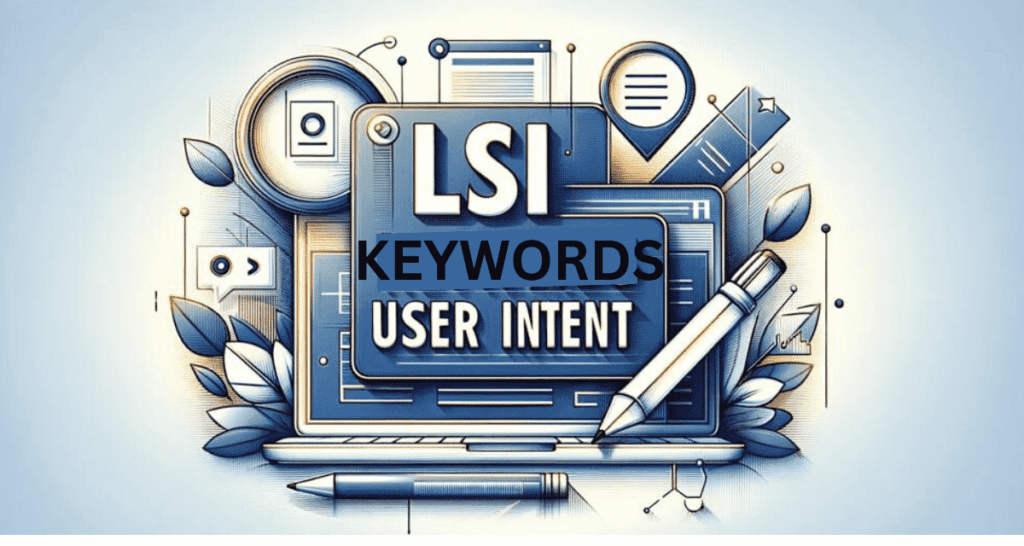As of digital marketing trends are up-scaling, keeping up with the latest trends is crucial. This comprehensive guide dives into the amazing topics of LSI Keywords and User Intent, shedding light on how these elements can supercharge your SEO strategy.
A Quick Look at LSI Keywords and User Intent
Why Are We Here?
This article aims to help you understand LSI (Latent Semantic Indexing) Keywords and User Intent, exploring their history, how they work, and how you can use them to boost your website’s visibility and engagement.
A Journey Through History
The Story of LSI Keywords


Where It All Began
To understand LSI Keywords, let’s go back to their beginnings. These keywords trace their roots back to the late 1980s when experts like Susan Dumais and George W. Furnas started laying the foundation for semantic search.
For more historical details, check out this informative article on the History of LSI.
LSI in SEO
LSI Keywords started making their way into SEO practices around the early 2000s. Search engines like Google recognized their potential for improving search results. This marked a turning point in SEO, emphasizing the importance of context and meaning in content optimization.
To learn more about the integration of LSI in SEO, read this guide on LSI in SEO.
The Evolution of User Intent Understanding
Early Search Engines
In the early days of search engines, understanding what users wanted was a bit of a guessing game. Search engines mostly relied on matching keywords, resulting in less accurate results. Users often had to dig through many pages to find what they needed.
Get a glimpse of how things have changed by checking out this overview of Search Engine Evolution.
Modern Algorithms
Advancements in algorithms and technology have revolutionized how we understand user intent. Machine learning and artificial intelligence, such as Google’s RankBrain, have made a big difference. They now help search engines understand context and intent better, leading to more relevant results.
Explore the impact of AI on search engines in this article on RankBrain.
LSI Keywords: How They Work
The In-Depths of LSI
The Math Behind It
At its core, LSI relies on math and statistics to analyze how words and phrases relate to each other in a sea of text. It creates a kind of “word neighborhood” where words with similar meanings hang out together. This helps search engines understand the context of your content and match it better with user queries.
For a deep dive into the math, check out this academic paper on Latent Semantic Indexing.
LSI and Natural Language Processing (NLP)


LSI Keywords and Natural Language Processing (NLP) work hand in hand to make search engines smarter. NLP algorithms can break apart and understand human language details, while LSI Keywords add more context. Together, they help search engines provide better results.
Explore the connection between LSI and NLP in this research paper on LSI and NLP Integration.
Separating Facts from Fiction
Common Myths
One common misunderstanding about LSI Keywords is that they’re all about synonyms. While synonyms are part of it, LSI analyzes a lot more. It looks at the whole context of a document and finds related concepts, not just synonyms.
What LSI Does in SEO
LSI Keywords aren’t a magic solution for SEO, but they’re a powerful tool when used right. They help search engines understand your content’s context and relevance. However, they should be part of a broader SEO strategy that includes quality content, backlinks, and other factors.
For practical tips on using LSI in your SEO strategy, visit this resource on LSI for SEO.
Getting to Know User Intent
Different Types of User Intent
Sorting Search Queries
User intent comes in various flavors, and each requires a different approach. There are informational, navigational, transactional, and commercial investigation intents. Understanding these categories is crucial for creating content that meets users’ specific needs.
Explore these intent categories further in this guide from SEMrush.
Case Studies: Intent in Action
Real-world case studies provide concrete examples of how different intent types affect search results. Studying these cases can give you insights into user behavior and guide your content strategy.
Discover intent-focused case studies in this collection from Search Engine Land.
AI and Understanding Intent


AI’s Role in Search Engines
AI-powered algorithms have transformed how search engines interpret user intent. These algorithms analyze massive datasets, recognize patterns, and adjust search results in real time to give users the most relevant information.
To get a deep dive into AI’s impact on search engines, read this article on AI in Search.
Real-life Examples
AI-driven intent analysis isn’t a far-off concept; it’s happening now. Google’s BERT, for instance, has improved how search engines understand the context of queries, resulting in more accurate results.
Explore practical examples of AI-driven intent analysis in this article on BERT.
Merging LSI Keywords with User Intent
Strategies for Keyword-Intent Harmony
Adding Context to Keywords
Connecting LSI Keywords with user intent starts with understanding where and how to use them. Adding context ensures your content connects with users looking for specific information, products, or services.
For practical tips on adding context to keywords, refer to this guide on Keyword Contextualization.
Making Content Relevant
Semantic optimization involves making your content more relevant and contextual using LSI Keywords and related terms. This not only boosts SEO but also enhances the user experience.
Bringing It All Together
Putting It into Action
Real-life examples show how businesses have successfully integrated LSI Keywords and user intent analysis into their content strategies. Case studies provide a roadmap for your own implementation.
Explore practical examples in this collection of Content Strategy Case Studies.
SEO Best Practices
Using LSI Keywords and user intent analysis effectively means following best practices. These practices cover content creation, on-page optimization, and monitoring your SEO performance.
For a comprehensive guide on SEO best practices, consult this resource from HubSpot.
Tools to Make Your Life Easier
Advanced Tools for LSI and Intent Analysis
Reviews and Comparisons
Many tools are available to simplify LSI and intent analysis, such as SEMrush, Moz, and Ahrefs. To find the best fit for your needs, it’s crucial to review and compare these tools thoroughly.
For in-depth software reviews and comparisons, check out this resource on SEO Tool Reviews.
Real-life Tool Success Stories
Case studies provide invaluable insights into how businesses have used these tools to gain a competitive edge. Studying real-life examples can guide your tool selection and implementation strategy.
Explore case studies on tool implementation in this archive from Search Engine Journal.
Step-by-Step Integration Guide
Making It Happen
Integrating LSI Keywords and user intent analysis into your SEO campaigns is a step-by-step process. From keyword research to content optimization, each phase requires careful planning and execution.
For a detailed step-by-step guide to integration, refer to this SEO Campaign Integration Guide.
Measuring Success
Success in SEO relies on data-driven decisions. To measure the impact of your LSI Keyword and intent-focused efforts, it’s crucial to track key performance indicators (KPIs) such as organic traffic, click-through rates, and conversion rates.
Learn how to measure success effectively in this guide on SEO KPIs.
Challenges and Considerations
Limitations of LSI and User Intent Analysis
Recognizing and Overcoming Challenges
While LSI Keywords and user intent analysis offer significant advantages, they have limitations. Challenges like data privacy concerns, search engine updates, and changing user behavior require attentiveness and adaptability.
To explore potential challenges and solutions, consult this resource on Overcoming SEO Challenges.
Anticipating Future Obstacles
The digital landscape is continually changing. Anticipating future obstacles is essential for staying ahead in the world of SEO. Pay attention to new developments in technology, changes in user behavior, and algorithm adjustments.
Stay informed about future obstacles in this forward-looking article on SEO Predictions.
Ethical and Practical Concerns
Balancing Automation and Human Insight
Integrating AI and automation in SEO raises ethical considerations. Striking the right balance between automation and human insight ensures that your SEO strategy remains authentic and user-centric.
Explore the ethical aspects of SEO automation in this mind-engaging article on AI Ethics.
Adapting to Search Engine Updates
To enhance user experience and combat spam, search engines update their algorithms on a frequent basis. Staying informed and adapting your SEO strategy accordingly is crucial to maintaining your online presence.
For tips on adapting to search engine updates, consult this guide on Algorithm Changes.
Insights from the Experts
Interviews with SEO Experts
What the Pros Say
Gaining insights from SEO experts and industry leaders is invaluable. Their experiences and expertise can provide valuable guidance for navigating the ever-changing SEO landscape.
Explore insightful interviews and insights from industry leaders on platforms like Search Engine Land.
Predicting the Future
The SEO landscape is always evolving. Staying ahead of the curve means analyzing trends and making informed predictions about future developments. Keep an eye on rising trends such as voice search, mobile optimization, and AI-driven SEO.
Stay informed about SEO trends and predictions through resources like Moz’s SEO Blog.
Wrapping It Up
Key Takeaways
In summary, this guide has provided you with a comprehensive understanding of LSI Keywords and user intent analysis. You now have the knowledge and tools to navigate the dynamic field of SEO confidently.
The Future of SEO with LSI and User Intent


As we look ahead, it’s clear that LSI Keywords and user intent analysis will continue to shape the SEO landscape. Embrace these concepts, adapt to changes, and stay at the forefront of digital marketing to maintain a competitive edge.
Where to Learn More
For a deeper dive into LSI Keywords and user intent analysis, consult academic and professional sources such as:
- Leveraging the Lastmod Tag in WordPress 6.5 for Superior SEO - May 23, 2024
- The Essential Role of Human Intervention in AI Content Creation - April 2, 2024
- Criteria for Google’s Spamming List: Avoiding the Pitfalls - April 1, 2024


Pingback: The Growth Of LSI In Search Engines - Shandigitalmarketing